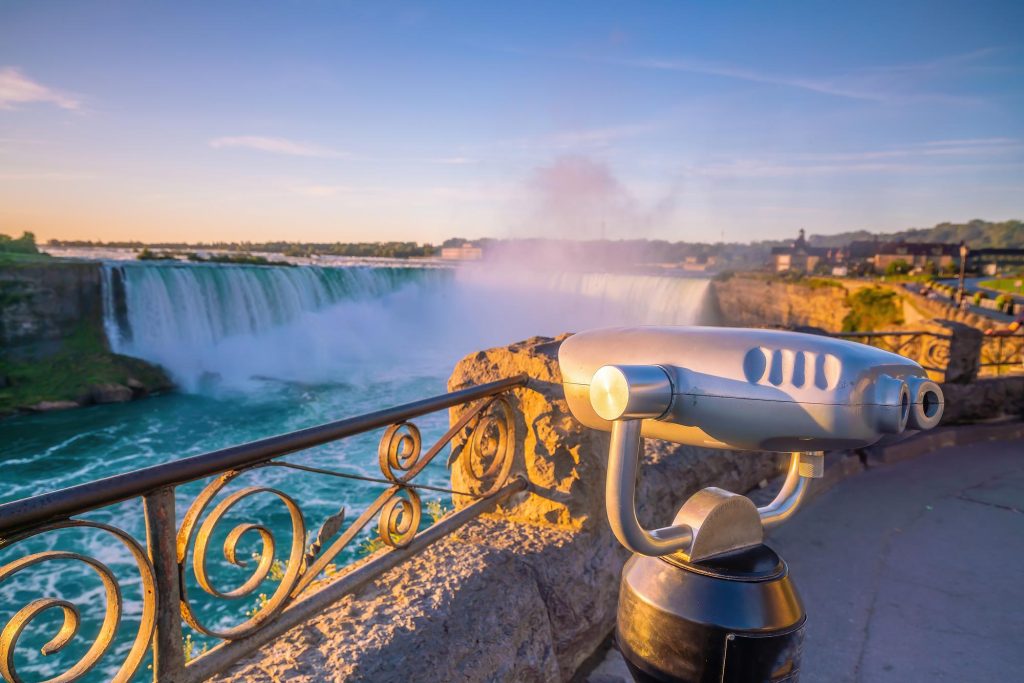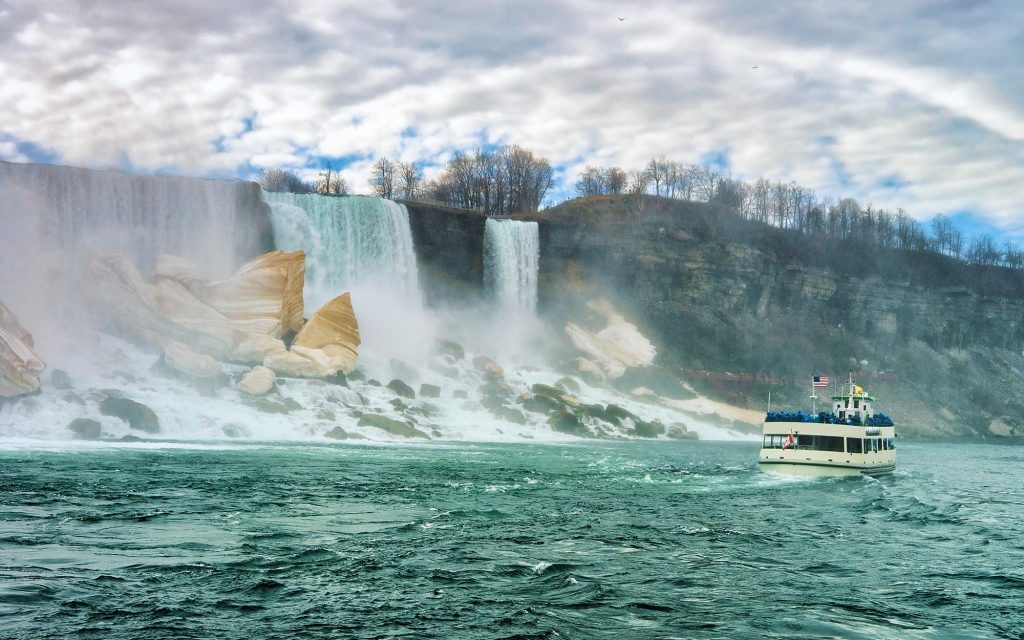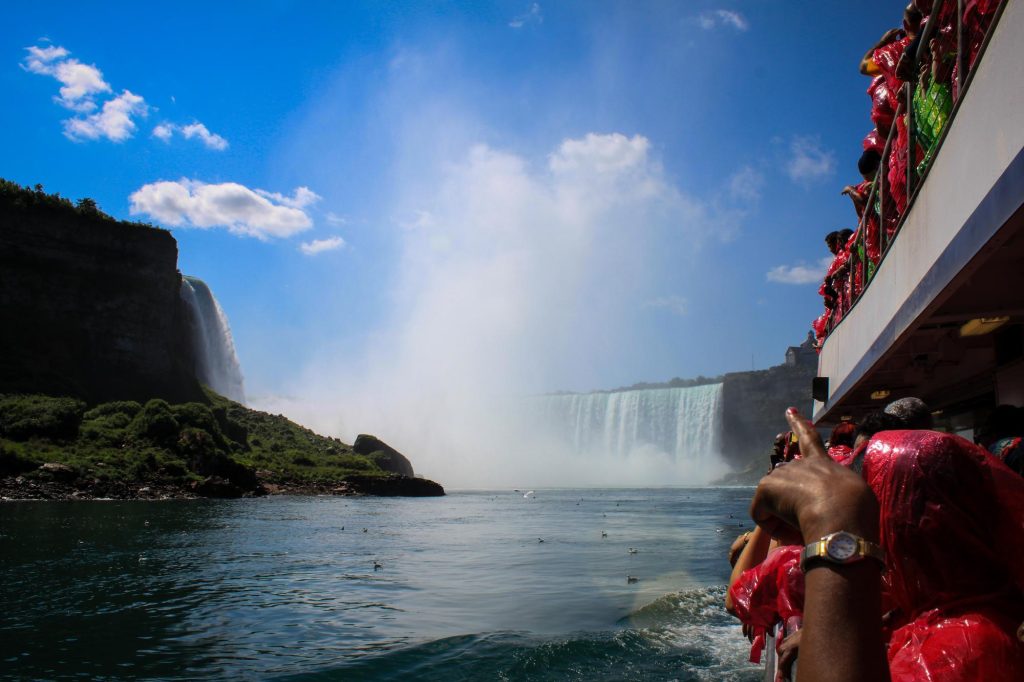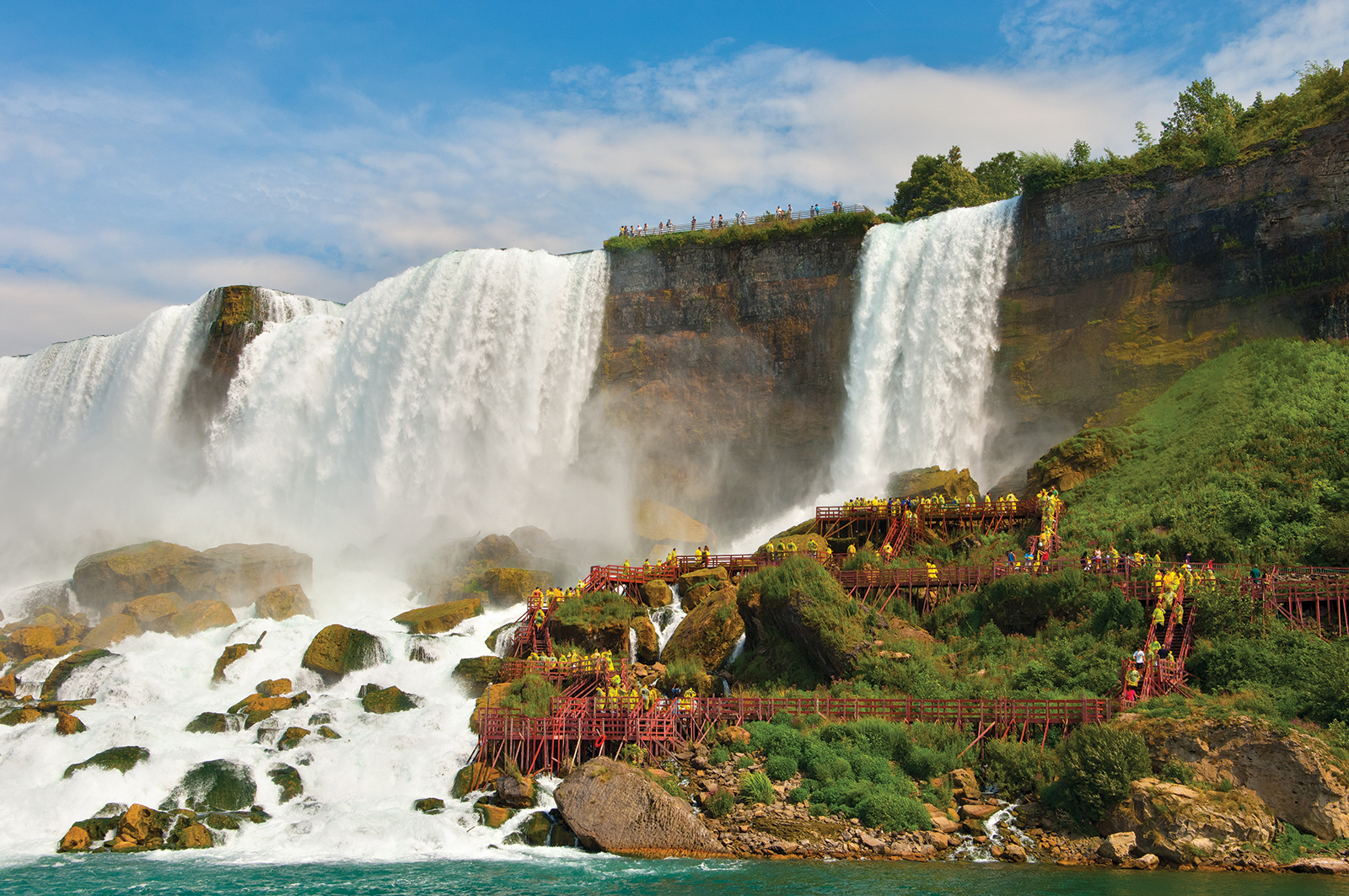Want to get kids engaged with history and several branches of science? Do it at Niagara Falls State Park and engage with nature
Niagara Falls undoubtedly gives its visitors a truly unforgettable experience, with its raging waterfalls and close encounters with nature’s wild beauty.
Which would make a bigger impression on your class regarding Niagara Falls?
A) Tell them that Niagara Falls has 3,160 tons of water flowing down it every second.
B) Take them to the Falls and stand under the pounding waters as they plunge 175 feet off the ledge above their heads.
Niagara Falls is an ideal student destination, teaching visitors about history, ecology and industrial significance. Since student groups, like Napoleon’s army, tend to travel on their stomachs, you’ll be glad to know about the Tastes of Niagara Food Court waiting to satisfy hungry visitors. Your group can find the food court in the new Ralph C. Wilson Jr. Welcome Center.
Niagara Falls State Park, America’s oldest state park, is a must-see for you and your group!
If you enjoy this content, be sure to Subscribe for FREE to Student Travel Planning Guide for in-depth field trips, unique student activities and student travel planning advice.

Sightseeing at Niagara Falls. Photo credit: Freepik Premium
A Trip into History at America’s Oldest State Park
Created in 1885, Niagara Falls became a state park, and even before that, it was already known as a tourist attraction and a honeymoon spot, thanks to Napoleon Bonaparte’s younger brother Joseph, who vacationed here with his new bride in 1804. Before that, it was an explorer’s goal; the first known European sighting of the Falls took place in 1678.
What Does Niagara Falls Teach Kids About Natural Science?
- Maid of the Mist is arguably one of the best ways to experience the falls. Students will climb aboard this double-decker tour boat and set sail into the frothing waters of Horseshoe and American Falls. The Maid of the Mist will leave your students awestruck by the power of the whitewater and the grandeur of Niagara’s monstrous rock formations.
- Cave of the Winds Tour will walk your students on the wet and wild side of the falls. Begin by plummeting 175 feet into the Niagara Gorge, then gear up in a rain poncho and prepare to brave the falls. Stroll through a stormy mist zone as you follow wooden walkways that wrap around the Niagara River and end at the Hurricane Deck. If your group comes by in the spring, special editions of the Cave tour allow visitors to see the decks and boardwalks being built for the upcoming peak season. And after peak season, an abbreviated version of the tour leads guests to observation platforms. Either way, it’s a uniquely up-close way to visit the Falls.
- Goat Island, located between American and Bridal Veil Falls, is another place that students interested in biology will want to visit. Students will get up close and personal with the creatures who live in and around Niagara Falls at uninhabited Goat Island. This spot offers views of both the American and Canadian sides of the park.
- The Aquarium of Niagara is only a few blocks away from the state park. It is a top-tier aquarium that showcases the ecosystems of everything from coral reefs to the Great Lakes. Here, your students can enjoy over 40 exhibits brimming with exciting creatures like sea lions, penguins, and sturgeon.
- Great Lakes 360 has recently taken the place of the Niagara Gorge Discovery Center. Here, visitors can explore diverse ecosystems of the world’s largest freshwater system through 16 new exhibits.
- Whirlpool Jet Boat Tours offer student groups opportunities to experience the power of The Falls on a 45-minute round trip Whirlpool Jet Boat Tour. Students 13 years and older and teachers and chaperones can depart from Queenston, Ontario, or Lewiston, New York, for an epic adventure. Travel into the Niagara Gorge, where groups can witness the majesty of 175-foot falls before making their way into the famed Niagara Whirlpool. End the tour with a trek through the Class V Devil’s Hole Rapids for an exciting experience.

Niagara Falls boat tour with a view of Niagara Falls State Park, Bridal Veil Falls, Goat Island and Horseshoe Falls in the background. Photo credit roman_babakin via Freepik Premium
What Can Kids Learn About Engineering at Niagara Falls?
There are three ways that students can learn about engineering on their trip to the Falls. And the emphasis in engineering in the Niagara Falls region is, understandably, on electricity. Combined, the three waterfalls that make up Niagara Falls can produce over 4 million kilowatts of electricity, which the U.S. and Canada share.
- The Terrain Map will help students can explore the idea of how electricity is made by seeing, a scale model of the Niagara area that shows how electricity can be produced from the mighty Niagara River.
- The Schoellkopf Power Station was constructed in three sections between 1905 and 1924, and at the time of its completion was the largest hydro-electric power station in the world. The complex included offices, gatehouses, and other buildings at the top of the gorge, and turbine-generator stations located at the base of the gorge. Water was diverted from the Niagara River above the falls, by a 4,600-foot canal that ran through the city to the edge of the gorge. When the last section of Station 3 was built, a pressure tunnel was constructed to bring additional water to the site. Water was collected at the forebay gatehouses where it entered penstocks down to the turbine-generator stations below. On June 7th, 1956, two-thirds of the power station was destroyed by a series of rockslides. In 2013, the Maid of the Mist began construction on the site as a location to store their boats during the harsh winter months. As part of that project, the original elevator shaft was restored and elevator access to the Gorge and the Schoellkopf site was granted.
- Illumination of Niagara Falls has been an attraction since 1860. Calcium flares were used originally to light the area however they were expensive and did not last long. In 1881, Charles Brush of Euclid, Ohio arrived in Niagara Falls with 16 electric carbon arc lights and a generator to illuminate the Falls. Schoellkopf offered the power from his water turbines to power Brush’s generator. This marked a milestone in the history of the illumination of Niagara Falls. Today illumination of the Falls occurs every night throughout the year.
- Niagara Power Vista offers educational STEM opportunities for school field trip groups. With more than 50 interactive exhibits, students have hands-on opportunities to understand hydroelectricity and electricity. Immersive STEM learning through educational tours and workshops are available by reservation.

Niagara Power Vista offers STEM learning opportunities for school groups. Photo credit: Freepik Premium
What Can Students Learn About Culture and History at Niagara Falls?
- Niagara Falls Underground Railroad Heritage Center provides school field trip groups with a guided tour of the Niagara Falls Underground Railroad Heritage Center, where visitors can learn about the lives of freedom seekers and abolitionists in Niagara Falls. During the Freedom Conversation Tour, get your students engaged in fascinating and authentic stories.
- Old Fort Niagara, open year-round, offers exceptional learning experiences for school field trip groups of all ages. Visitors will experience an introductory exhibit, an orientation video and a vast collection of authentic artifacts, including the 1812 garrison flag. They will also tour the historic grounds, which include 18th-century fortifications, and learn about daily life for men and women who lived and worked at Fort Niagara through living history programs. Students can experience historic weapons demonstrations, Native American history programs, Women of the Army programs, military tactics demonstrations and military music programs.
- Observation Tower is the only spot in the entire park that offers a panoramic view of all three falls. After you’ve spent a few moments gazing down at the falls below, turn your eyes to the sky and try to catch a glimpse of the peregrine falcons and bald eagles who call the Falls home.
What Dining Options Are Recommended for Student Group Trips to the Falls?
At some point, no matter how great the destination is, kids need food. Or else, as we all know, you can forget about learning – or even a moderate amount of happiness. A variety of places throughout Niagara Falls State Park can help you keep your kids happy and energized. Boxed lunches are also available for student groups.
For a quick lunch or a snack, your group has a couple of convenient options. On Goat Island, the Cave of the Winds Snack Bar keeps hunger at bay with pizza, fries and other quick bites. Niagara Falls State Park’s new Ralph C. Wilson Jr. Welcome Center houses the Tastes of Niagara Food Court, offering many options for even the pickiest eaters.
If you want a truly memorable dining experience, don’t pass up the Top of the Falls Restaurant. Snacks you can get anywhere; views are not so easy to come by. And that’s what Top of the Falls specializes in. Also on Goat Island, and with scenic views of the waterfalls, this is the place to enjoy modern takes on American food. Whenever possible, ingredients are locally sourced, and dietary restrictions are honored. The menu includes regional twists on mac and cheese, fish and chips, and salads, plus kid-friendly choices like grilled cheese sandwiches and pizza.
Maybe this will be the year when you get to do more than just tell your students about how great the planet is. Maybe this is when you’ll get to show them – by a trip to Niagara Falls State Park.

Take your students on a Niagara Falls boat tour and experience the power of Mother Nature. Photo credit: Freepik Premium
For more information on what’s available for groups in our destination, feel free to check out our travel trade section of our website! Click here for the Student & Youth Group page, and here for our group tour itineraries.
Been to Niagara Falls with a student group? Let us know how it went! Tell your story in the comments section below.
Be sure to Subscribe for FREE to discover more intriguing student travel insights and planning tips.






